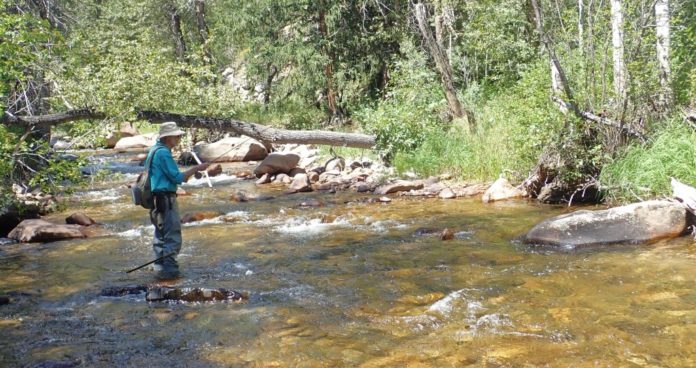John Gierach is a patient man. He was all geared up and ready to fish. Meanwhile, my stuff was scattered all over the tailgate of his truck, which we’d parked along the Middle Fork of the St. Vrain River.
This season I’d taken it upon myself to simplify my fly fishing, which translates roughly to reducing the amount of junk I carry on the stream for a day of fishing. This was the first trip where I’d put these ideas into practice. I would carry one fly box, some spare tippet material (4X and 5X for a small streams), nippers, fly floatant and a few other essential do-dads.
I wasn’t going to use a fishing vest or hip pack to carry the stuff. I wanted it to fit in the pockets of my shirt. If there was any overflow, I had room in my cargo pants that would be accessible since I was wearing hip waders.
The holdup was that I was having trouble figuring out the best pockets to put the stuff in. I wanted things like fly floatant and the fly box to be readily available, but if I jammed too much stuff into the most easily accessed pockets, I wouldn’t be able to quickly get hold of what I wanted. During the process, I’d lost track of my nippers, which were attached to a retractor that I could pin to my shirt for easy access.
The nippers were still missing after I’d sorted everything else out, so I rummaged through my stuff for a spare pair and stuck them in my pocket. It may sound like I’d just dreamed all this simplified fly fishing stuff up, but that’s not true. A number of years ago I’d had a similar system that I remembered worked pretty well for small streams. It seemed like I was doing a lot more fiddling around to get it that way this time.

I eventually called out to John that I was sorry for the delay. “No problem, take all the time you want,” he responded. He was quietly watching the river.
I could have excused my fussing around by thinking that John has fished the St. Vrain for all of his adult life and could gear up in his sleep for a day’s fishing, but there’s more to it than that. He fishes the entire St. Vrain River drainage better than anyone I know. I’m just a visitor who shows up now and then and asks whether he’ll go fishing with me and he always comes up with a good spot.
This was one of those clear, sharp Colorado mornings that you get toward the end of August and into September. The water was running at what I figured was an average volume for this time of year, although on the ride up to the river, John said it’s hard to characterize what normal is after the floods, toxic spills and years of drought.
We were looking at water structured with shallow riffles, deeper pools and slicks behind instream rocks. John said this is brown trout habitat and they often like to hold in the slower moving water, but not to neglect fishing the riffles. I rigged up with a size #14 Elk Hair Caddis with a green Flash Midge for a trailer.

I’d been fishing the tailwaters a lot recently, and it took me a while to get used to the confines of a small stream. There’s plenty of vegetation along the banks just waiting to snag your fly if you don’t pay attention. I also had to shorten the distance between my dry fly and dropper because the dropper was snagging bottom too often. John’s rod was already bent into his first fish when I glanced upstream between minor catastrophes. By the time I did get into a fishing rhythm and began working my way upstream to him he was sitting on a rock near a section of water that featured some deeper holes, slicks and well-defined seams separating faster moving from slower moving water. The kind of places where you expect to find trout.
I sat down and we exchanged fishing reports. John had brought a trout to hand and missed a couple of strikes. I thought I’d seen a trout flash near my dropper fly but I wasn’t sure.
When we finished with the pleasantries, John pointed his fly rod at a sweet looking seam and said, “You take it”. That’s his way of putting me on the best water. He then leap-frogged upstream making sure to leave some unfished water between us before he started fishing.
I hooked up a chunky eight-inch brown trout on my second cast. It took the Flash Midge. When I eventually worked my way upstream to John, he was playing a nice trout. We both commented on how clean and perfect the trout we’d caught were. Both of us also noted that we weren’t seeing any insects in the air and wondered why. Any kind of insect hatch on a small stream like the St. Vrain always seems to energize the trout to the point that they’ll take almost any fly you drift over them.
We continued clattering upstream (I say “clattering” because we both use wading staffs these days) and leap frogging each other to unfished water. By the time we called it a day, I’d caught another fish and missed a few strikes. John, as usual, did better.
It wasn’t the kind of day where you catch one fish after another. John tried to apologize for the lack of trout, but I cut him off. We’d both caught and released a few perfect brown trout; the sun was shining and there was no wildfire smoke in the air. That’s a good day of fishing.
Visit EdEngleFlyFishing.com to see Ed Engle’s blog, “The Lone Angler Journal.”
Credit: Source link































